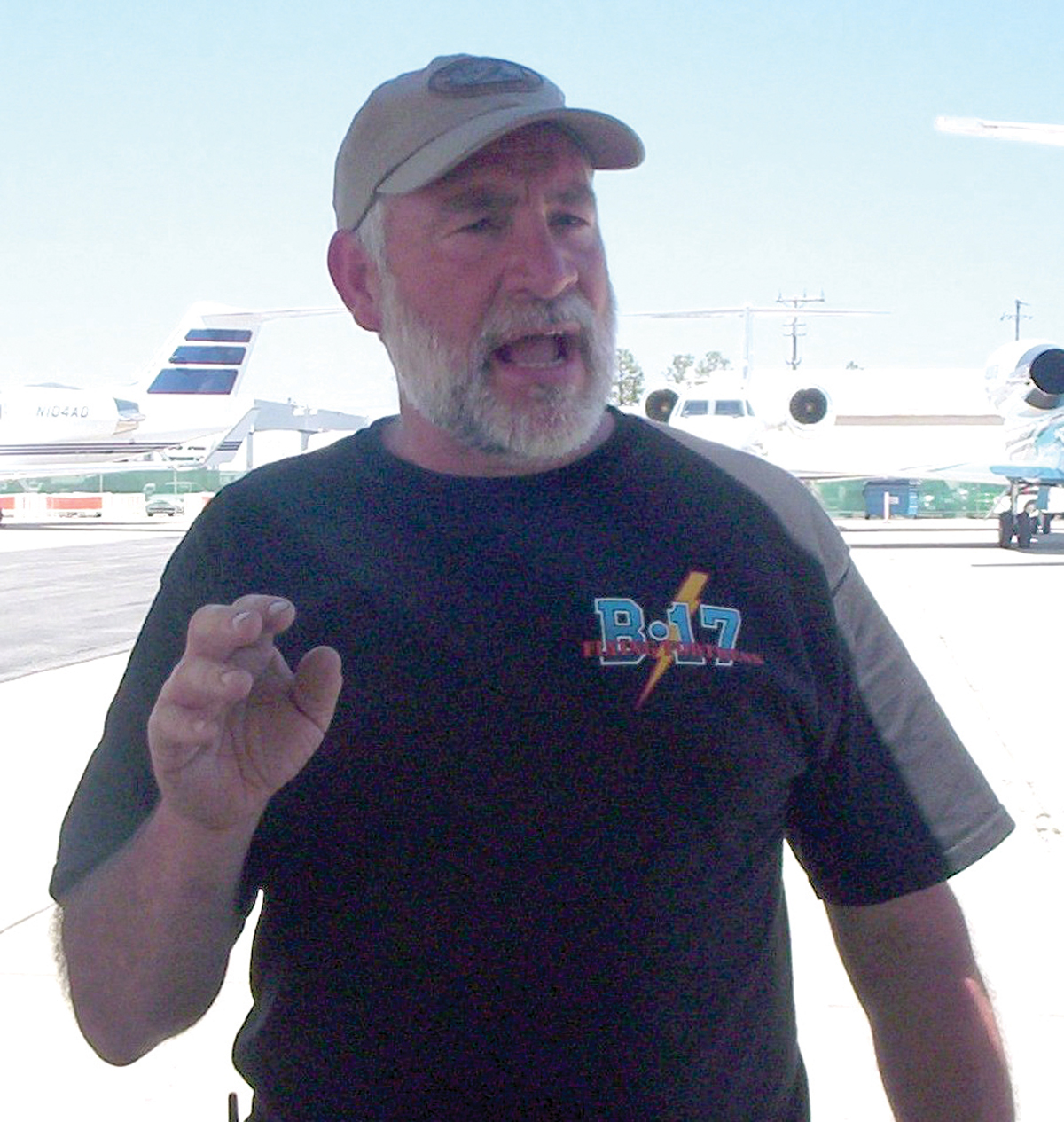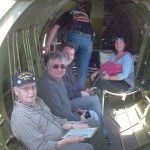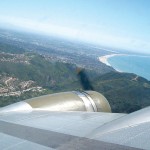By Fred “Crash” Blechman,
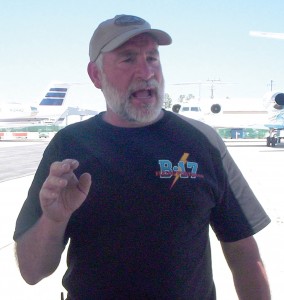
Bill Hooten, tour aviation maintenance officer, gave us a detailed briefing before the flight, and made sure the eight passengers were comfortable during the flight.
Of the 12,731 four-engine Boeing B-17 Flying Fortresses built in the late 1930s and early 1940s, only 14 of these long-range bombers are still airworthy. I recently flew in one of them, the Experimental Aircraft Association’s Aluminum Overcast.
Although this B-17G usually tours annually, it experienced a gear collapse on rollout after landing at Van Nuys Airport two years ago. It was in repair and restoration at EAA headquarters in Oshkosh, Wis., until March 31, when it began this year’s tour in San Diego.
So it was a special “Return to Van Nuys” when Aluminum Overcast flew into the airport on the morning of April 13 and parked at Syncro Aviation’s tarmac. Several folks, including yours truly, were treated to a media flight announcing its five-day visit. EAA Chapter #40 hosted the visit; member Anne Marie Radel was on hand to coordinate the activities for the flight, as well as those that would take place on the following days.
I got to chat before our flight with Dave Mann, who was pilot in command on the flight into Van Nuys from Fox Field in Lancaster. He was a fixed wing aviator in the Army and has flown 99 different aircraft, including jets. He flew fire bombers in Alaska and was a corporate pilot out of Vienna, Austria, for eight years.
His regular job is vice president and general manager of Batten International Airport in Racine, Wis., 12 miles south of Milwaukee. Since December 1950, Batten has been the largest privately-owned airport in the United States.
Dave said that nine qualified EAA B-17 pilots alternate in the pilot and copilot positions during the flights, and the pilot crews change during the tour.
“I’m out 19 days this time, and someone else relieves me at Mountain View,” he said. “Then two months later I’m back on.”
The copilot on the arrival was Dan Bowlin. He commented that the airplane was born before he was.
“We were too young to fly in combat in WWII, but we’ve flown many years with the EAA,” he said.
He pointed out that during the aircraft’s two-year restoration period, all four Wright-Cyclone nine-cylinder 1,200-hp engines were overhauled, since you can’t buy a new one. The cruising speed is 150 to 160 miles per hour, using about 200 gallons of fuel per hour (total) for the four engines.
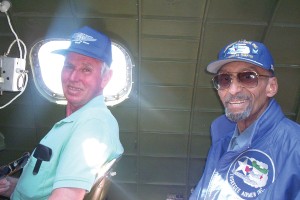
Photographer Lee Auger (left) and former Tuskegee B-25 pilot O. Oliver Goodall took two of the seats in the radio compartment.
Eight passengers are allowed on each flight. Among those on my flight were Anne Marie, Lieutenant Commander Don McMillan (former Navy WWII torpedo bomber pilot), radio reporter Lance Orozco, video cameraman Mark Drew, veteran Tuskegee Airman O. Oliver Goodall and photographer Lee Auger.
Bill Hooten, tour aviation maintenance officer, held the briefing for the flight. He explained where, if needed, four exits were located, how to fasten, adjust and release our safety belts, and that we had to be in our seat belts for takeoff and landing, but otherwise could move around the plane during the flight.
Bill also pointed out that the flight would be noisy and offered free earplugs. He then helped us enter the door on the right side of the plane near the rear, allowed us to select our seats, and made sure our seatbelts were properly adjusted.
Several canvas seats were inside the main section of the fuselage, with large windows and guns on each side. Three seats were in the radio compartment, a single seat in the bombardier’s nose section and a jump seat behind the copilot. I chose the radio operator’s seat and table (complete with an original Morse code key) on the left side of the plane over the wing, forward of the ball turret, but behind the bomb bay section. I had a large window just off my left shoulder, and took the opportunity to take many photos during the flight. Looking ahead through the narrow bomb bay walkway, I could see the cockpit.
The pilot in command, in the left seat on this flight, was Dan Bowlin, while Dave Mann took the right seat.
They busily went over the takeoff check list, started all four engines and taxied out toward the main runway, 16R. As we passed by the Condor Squadron (a group of AT-6/SNJ WWII training planes) I spotted serial #90918, an SNJ I flew solo on a gunnery flight on Feb. 23, 1950, while in Navy pilot training. It’s now painted to resemble a German fighter plane! (It’s one of two “German” Condor Squadron planes used to “attack” the Liberty Ship S.S. Lane Victory on summer weekends while on its way to Catalina Island from San Pedro.)
We lined up on Runway 16R, and took off at 1:30 p.m., to the loud roar of the engines. We smoothly lifted off, climbed south, and soon turned right, heading west, paralleling the Santa Monica Mountains on our left, with the Ventura Freeway below slightly on our right. As we climbed, we could see over the mountains, with a clear view of downtown Los Angeles behind us. To our left was Malibu, the Pacific Ocean coastline, Santa Monica Municipal Airport and Los Angeles International Airport, and in the distance we could even see the Palos Verdes hills and Long Beach. It was very clear and the air was smooth as glass.
Soon we turned left, making a broad 270-degree turn over the mountains. No wonder this was called a “valley.” With this good visibility we could see that the San Fernando Valley was surrounded on all four sides by mountain ranges, some snow-capped. Now headed north over Van Nuys, Warner Center and West Hills Hospital were easily visible about five miles to our left. As we turned base leg and then final on our approach to Van Nuys Airport Runway 16R, the entire east end of the valley was in view, including the “four stacks” southeast of Whiteman Airport. We landed at 1:45. Amazing how much ground we covered in just 15 minutes!
It was a very comfortable flight. I couldn’t help thinking of what it must have been like to be in a B-17 flying high for hours over enemy territory, wearing heavy winter clothing, breathing through an oxygen mask. Never knowing when an enemy fighter plane would attack, when anti-aircraft fire would destroy your flying cocoon, when you would have to quickly find your parachute, buckle it on, and try to jump out of a twisting derelict that threw you away from any exit. And, if you survived, having to go back and do it again another day!
We exited the plane from the same door as we entered. Mark Drew had a large video camera that he positioned using a type of steering wheel. He was doing video for KOCE-TV, Orange County Public Television. This was his first flight in a four-engine bomber.
“It was incredible,” he said. “I wasn’t in charge of the bombs on this flight, so I didn’t strike the target. I was just documenting it.”
Lance Orozco was doing commentary for KCLU, the National Public Radio station that covers Santa Barbara and Ventura counties in Southern California, and also KOCE-TV.
“There’s no way to describe it,” he said of the flight. “This was like a page out of history. It was magnificent. Looking out over the wing of the plane, I felt like I was back in a history book. I’d seen these at air shows, never thinking I’d get a chance to go up in one!”
To make a reservation or check Aluminum Overcast’s schedule, visit [http://www.b17.org]. Fred Blechman’s two flying books, “Bent Wings—F4U Action & Accidents: True Tales of Trial & Terror!” and “Flying with the Fred Baron,” are available at [http://amazon.com] or [http://bn.com].
- L to R: Retired Lieutenant Commander Don McMillan, Lance Orozco, Mark Drew, Bill Hooten and Anne Marie Radel inside the main section of Aluminum Overcast’s renovated fuselage.
- On a clear day you can see forever—or at least far south along the Pacific Ocean coastline from above the Santa Monica Mountains.











